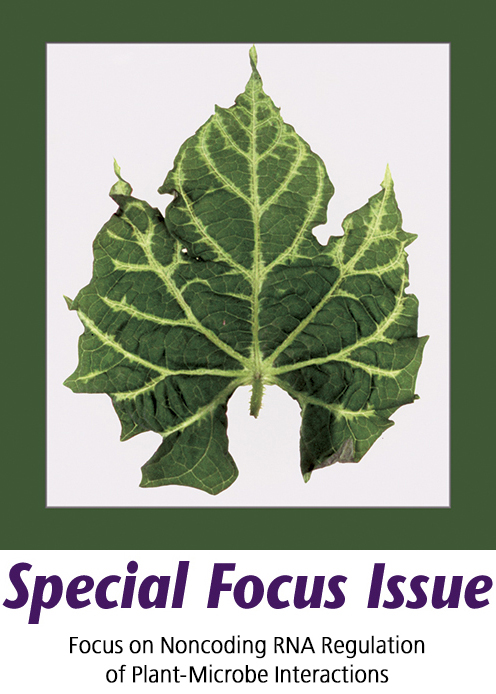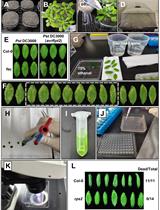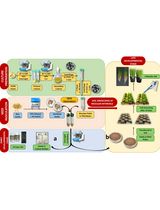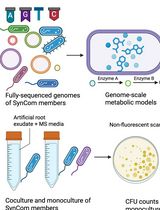- EN - English
- CN - 中文
Extraction, Purification and Quantification of Diffusible Signal Factor Family Quorum-sensing Signal Molecules in Xanthomonas oryzae pv. oryzae
水稻黄单胞菌水稻致病变种可扩散信号因子家族中群体感应信号分子的提取、纯化和定量
发布: 2017年03月20日第7卷第6期 DOI: 10.21769/BioProtoc.2190 浏览次数: 11128
评审: Zhaohui LiuSadri ZnaidiManuela Roggiani
Abstract
Bacteria use quorum-sensing (QS) systems to monitor and regulate their population density. Bacterial QS involves small molecules that act as signals for bacterial communication. Many Gram-negative bacterial pathogens use a class of widely conserved molecules, called diffusible signal factor (DSF) family QS signals. The measurement of DSF family signal molecules is essential for understanding DSF metabolic pathways, signaling networks, as well as regulatory roles. Here, we describe a method for the extraction of DSF family signal molecules from Xanthomonas oryzae pv. oryzae (Xoo) cell pellets and Xoo culture supernatant. We determined the levels of DSF family signals using ultra-performance liquid chromatographic system (UPLC) coupled with accurate mass time-of-flight mass spectrometer (TOF-MS). With the aid of UPLC/MS system, the detection limit of DSF was as low as 1 µM, which greatly improves the ability to detect DSF DSF family signal molecules in bacterial cultures and reaction mixtures.
Keywords: Quorum sensing (QS) (群体感应(QS))Background
Xanthomonas oryzae pv. oryzae (Xoo) is a causal agent of bacterial blight disease of rice, and produces multiple DSF family QS signals, including cis-11-methy-dodecenoic acid (DSF), cis-2-dodecenoic acid (BDSF), cis-10-methyl-2-dodecenoic acid (IDSF) and cis,cis-11-methyldodeca-2,5-dienoic acid (CDSF), to regulate virulence factor production (Figure 1). The biosynthesis, perception, and turnover of DSF family signals require components of the rpf (regulation of pathogenicity factors) cluster in Xoo. RpfF is a key DSF biosynthase with both acyl-ACP thioesterase and dehydratase activity. The two-component system, comprising the sensor kinase RpfC and the response regulator RpfG, plays an essential role in the perception and transduction of DSF family signals. RpfB has recently been characterized as a fatty acyl-CoA ligase (FCL), which functions in DSF family signal turnover in Xanthomonas (Wang et al., 2016; Zhou et al., 2015b). Deletion of rpfB in Xoo strain PXO99A leads to an over-production of DSF and BDSF and reduced production of extracellular polysaccharide (EPS), extracellular amylase activity. Moreover, attenuated pathogenicity has also been observed (Wang et al., 2016). Therefore, the RpfB-dependent DSF family signal turnover system is considered a naturally occurring signal turnover system in Xanthomonas. Detection and quantification of DSF family signals are very important in understanding the mechanisms of the DSF signaling system. As a result, detection methods for these signals have improved over the past few years. Initially, DSF detection relied on genetically engineered DSF biosensor-based detection systems (Slater et al., 2000; Wang et al., 2004), which provide an indirect way to analyze the activity of DSF family signals without differentiating structurally similar members of this group. Later, a detection method based on high-performance liquid chromatography (HPLC) was developed, which allowed a direct quantification of production levels of DSF family signal molecules by Xanthomonas (Wang et al., 2004; He et al., 2010; Zhou et al., 2015a). Recently, this HPLC-based method was further improved by using ultra performance liquid chromatographic system/ mass spectrometry (UPLC/MS),which offers better sensitivity and accuracy in the measurement of DSF family signals produced by Xoo, which will be presented in detail in this protocol (Zhou et al., 2015b; Wang et al., 2016).
Figure 1. Chromatogram of ethyl acetate extract of the culture supernatant of the DSF hyper-production mutant ΔrpfCΔrpfB of Xoo strain PXO99A. A. Four molecules of the DSF family QS signals are detected in the supernatant of ΔrpfCΔrpfB in nutrient broth. Among them, DSF and BDSF are the predominant signal molecules. B. The chemical structure of the four DSF family signal molecules.
Materials and Reagents
- Pipette tips
2-100 μl (Eppendorf, catalog number: 0030000.870 )
50-1,000 μl (Eppendorf, catalog number: 0030000.919 )
1-10 ml (Eppendorf, catalog number: 0030000.765 ) - 2.0 ml microtubes (Corning, Axygen®, catalog number: MCT-200-C )
- pH test strips (0.0-6.0 pH) (Sigma-Aldrich, catalog number: P4661 )
- 1.5 ml microtubes (Corning, Axygen®, catalog number: MCT-150-C )
- 50 ml centrifuge tube (Corning, catalog number: 430829 )
- Acrodisc® MS syringe filters (0.2 µm, 13 mm, WWPTFE membrane) (Pall, catalog number: MS-3301 )
- BD Tuberculin syringe with detachable needle (1 ml, 27 G x 1/2 in.) (BD, catalog number: 309623 )
- 1.5 ml Semi-micro cuvette (AS ONE, catalog number: 1-2855-02 )
- HPLC screw cap vials (Agilent Technologies, catalog number: 5182-0714 )
- 400 µl polypropylene flat bottom insert (Agilent Technologies, catalog number: 5183-2087 )
- Zorbax Eclipse XDB-C18 reverse phase column (Analytical, 4.6 x 150 mm, 5-micron) (Agilent Technologies, catalog number: 993967-902 )
- Sterile Petri dishes (90 mm) (Sartorius, catalog number: 14-555-735 )
- Xoo strain ΔrpfB, the rpfB deletion mutant of Xoo strain PXO99A, which overproduces DSF family signal molecules (Wang et al., 2016)
- Cephalexin (Sigma-Aldrich, catalog number: 1099008 )
- DSF (cis-11-methy-dodecenoic acid) (HPLC grade, purity ≥ 90.0%) (Sigma-Aldrich, catalog number: 42052 )
- BDSF (cis-2-dodecenoic acid) (HPLC grade, purity ≥ 90.0%) (Sigma-Aldrich, catalog number: 49619 )
- 6 N hydrochloric acid solution (HCl) (Sigma-Aldrich, catalog number: 13-1686 )
- Ethyl acetate (ACS reagent grade, purity ≥ 99.5%) (Sigma-Aldrich, catalog number: 676810 )
- Methanol (HPLC grade) (Fisher Scientific, catalog number: A452-4 )
- Phosphate buffered saline (PBS, pH 7.4) (Sigma-Aldrich, catalog number: P5368 )
- Glycerol (Sigma-Aldrich, catalog number: 49781 )
- Bacto peptone (BD, BactoTM, catalog number: 211677 )
- Bacto beef extract (BD, BactoTM, catalog number: 211520 )
- Sucrose (VetecTM reagent grade) (Sigma-Aldrich, catalog number: V900116 )
- BBL yeast extract (BD, BBL, catalog number: 211931 )
- NaOH
- Agar (BD, catalog number: 281230 )
- Sodium acetate (ACS reagent grade, purity ≥ 99.0%) (Sigma-Aldrich, catalog number: 791741 )
- Acetic acid (ACS reagent grade, purity ≥ 99.7%) (Sigma-Aldrich, catalog number: 695092 )
- Sterile deionized H2O
- Glycerol stock (see Recipes)
- Nutrient broth (NB, see Recipes)
- Nutrient agar (NA, see Recipes)
- 0.2 M sodium acetate solution (pH 8.0) (see Recipes)
- 0.2 M acetic acid solution (pH 2.7) (see Recipes)
- 0.2 M sodium acetate buffer (pH 3.8) (see Recipes)
- Cephalexin stock solution (20 mg/ml, see Recipes)
Equipment
- Corning® glass Erlenmeyer flasks with screw cap
50 ml (Corning, catalog number: 4985-50 )
250 ml (Corning, catalog number: 4985-250 ) - MaxQTM 6000 Incubated/Refrigerated shaker (Thermo Fisher Scientific, Thermo ScientificTM, model: MaxQTM 6000 , catalog number: SHKE6000-8CE)
- UV-visible spectrophotometer (Thermo Fisher Scientific, Thermo ScientificTM, model: BioMateTM 3S )
- Microcentrifuge (Thermo Fisher Scientific, Thermo ScientificTM, model: SorvallTM LegendTM Micro 17R )
- Centrifuge (Thermo Fisher Scientific, Thermo ScientificTM, model: HeraeusTM MultifugeTM X1R )
- Vortex mixer (VWR, catalog number: 10153-840 )
- CentriVap benchtop concentrator with glass lid (Labconco, catalog number: 7810040 )
- Pipettes
10-100 μl (Eppendorf, catalog number: 3120000046 )
100-1,000 μl (Eppendorf, catalog number: 3120000062 )
1-10 ml (Eppendorf, catalog number: 3120000089 ) - Fume hood
- Refrigerator (MEILING BIOLOGY & MEDICAL, model: DW-YL270 )
- VibracellTM High Intensity Ultrasonic Liquid Processors (Sonics & Materials, model: VCX 500 ) connected with a Tapered Microtip probe (tip diameter: 3 mm) (Sonics & Materials, catalog number: 630-0422 )
- Digital precise water bath (DAIHAN Scientific, model: WB-6 )
- Pear shaped glass flask, Ts 29/38, 100 ml (Tokyo Rikakikai, EYELA, catalog number: 116150 )
- UPLC/MS system
Ultra-performance liquid chromatographic system (UPLC) (Agilent Technologies, model: Agilent 1290 Infinity LC ) coupled with an accurate mass time-of-flight (TOF) MS (Agilent Technologies, model: Agilent 6230 Accurate-Mass TOF MS ) equipped with an Agilent Jet Stream (AJS) electrospray ionization (ESI) source - Diode array detector (Agilent Technologies, model: G4212A )
- pH meter (Mettler Toledo, model: FE20 )
- Diaphragm vacuum pump (Labconco, catalog number: 7393001 )
- Rotary evaporator (Tokyo Rikakikai, EYELA, model: N-1100 )
- Circulation cooling-water system (Tokyo Rikakikai, EYELA, model: CCA-1111 )
- Autoclave (Panasonic Healthcare, model: MLS-3781L )
Software
- Agilent MassHunter Workstation Data Acquisition Software (revision B.04)
Procedure
文章信息
版权信息
© 2017 The Authors; exclusive licensee Bio-protocol LLC.
如何引用
Zhou, L., Wang, X., Zhang, W., Sun, S. and He, Y. (2017). Extraction, Purification and Quantification of Diffusible Signal Factor Family Quorum-sensing Signal Molecules in Xanthomonas oryzae pv. oryzae. Bio-protocol 7(6): e2190. DOI: 10.21769/BioProtoc.2190.
分类
微生物学 > 微生物生物膜 > 群体感应因子
植物科学 > 植物免疫 > 宿主-细菌相互作用
生物化学 > 其它化合物 > 酸
您对这篇实验方法有问题吗?
在此处发布您的问题,我们将邀请本文作者来回答。同时,我们会将您的问题发布到Bio-protocol Exchange,以便寻求社区成员的帮助。
提问指南
+ 问题描述
写下详细的问题描述,包括所有有助于他人回答您问题的信息(例如实验过程、条件和相关图像等)。
Share
Bluesky
X
Copy link














